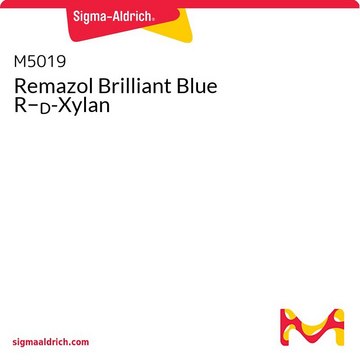X2629
endo-1,4-β-Xylanase from Trichoderma longibrachiatum
Synonym(s):
1,4-β-D-Xylanxylanohydrolase
Sign Into View Organizational & Contract Pricing
All Photos(2)
About This Item
EC Number:
MDL number:
UNSPSC Code:
12352204
Recommended Products
form
powder
specific activity
≥1.0 units/mg solid
composition
Protein, ≥10%
greener alternative product characteristics
Waste Prevention
Learn more about the Principles of Green Chemistry.
greener alternative category
storage temp.
room temp
General description
We are committed to bringing you Greener Alternative Products, which adhere to one or more of The 12 Principles of Greener Chemistry. This product has been enhanced for waste prevention when used in cellulosic ethanol research. For more information see the article in biofiles.
Biochem/physiol Actions
Primary activity is an acid-neutral endo-1,4-β-D-xylanase, additional activities include β-glucanase, cellulase, pectinase, mannanase, xyloglucanase, laminarase, β-glucosidase, β-xylosidase, α-L-arabinofuranosidase, amylase, and protease.
Unit Definition
One unit will liberate 1 μmole of reducing sugar measured as xylose equivalents from xylan (Cat. No. X0627) per min at pH 4.5 at 30 °C.
Signal Word
Danger
Hazard Statements
Precautionary Statements
Hazard Classifications
Resp. Sens. 1
Storage Class Code
11 - Combustible Solids
WGK
WGK 3
Flash Point(F)
Not applicable
Flash Point(C)
Not applicable
Certificates of Analysis (COA)
Search for Certificates of Analysis (COA) by entering the products Lot/Batch Number. Lot and Batch Numbers can be found on a product’s label following the words ‘Lot’ or ‘Batch’.
Already Own This Product?
Find documentation for the products that you have recently purchased in the Document Library.
Customers Also Viewed
Jiao Tang et al.
Applied microbiology and biotechnology, 103(7), 3037-3048 (2019-02-15)
The thermophilic fungus Thielavia terrestris when cultured on cellulose produces a cocktail of thermal hydrolases with potential application in saccharification of lignocellulosic biomass and other biotechnological areas. Glucuronoyl esterases are considered to play a unique role as accessory enzymes in
Zhenghui Liu et al.
Frontiers in bioengineering and biotechnology, 9, 814246-814246 (2022-02-15)
Supplementing commercial xylanase and cellulase with selected debranching enzymes only resulted in slight enhancement of the enzymatic hydrolysis of wheat bran autohydrolysis residues (WBAR) which was obtained at 160°C over a 30-min period of autohdyrolysis, while a blend of enzymes
Amélie de Vallée et al.
Frontiers in microbiology, 10, 2829-2829 (2019-12-24)
The gray mold fungus Botrytis cinerea is a necrotrophic pathogen able to infect hundreds of host plants, including high-value crops such as grapevine, strawberry and tomato. In order to decipher its infectious strategy, a library of 2,144 mutants was generated
Ichiro Kamei et al.
Bioresource technology, 126, 137-141 (2012-10-18)
We propose a new process of unified aerobic delignification and anaerobic saccharification and fermentation of wood by a single microorganism, the white-rot fungus Phlebia sp. MG-60. This fungus is able to selectively degrade lignin under aerobic solid state fermentation conditions
Maija Tenkanen et al.
The FEBS journal, 280(1), 285-301 (2012-11-22)
A minor xylanase, named XYN IV, was purified from the cellulolytic system of the fungus Trichoderma reesei Rut C30. The enzyme was discovered on the basis of its ability to attack aldotetraohexenuronic acid (HexA-2Xyl-4Xyl-4Xyl, HexA(3)Xyl(3)), releasing the reducing-end xylose residue.
Our team of scientists has experience in all areas of research including Life Science, Material Science, Chemical Synthesis, Chromatography, Analytical and many others.
Contact Technical Service








